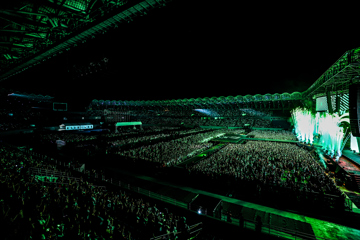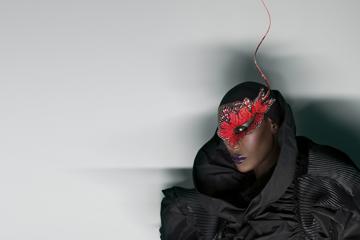Film Carew
You can appreciate the singularity of Maddin’s work, his unbroken devotion to an idiosyncratic auteurism.
In 2000, Guy Maddin was commissioned to make a short film for the 25th Toronto International Film Festival, the only stipulation being that cinema play a role in the story. It was a banal brief that, unexpectedly, became the oddball Canadian auteur's finest hour. Or, at least, six minutes. The Heart Of The World is the feverish, frenetically-edited, Sviridov-scored apex of Maddin's singular shtick, in which he takes archaic tools —borrowing the near-centuries old 'technology' of '20s silent films— and constructs feverish passion-plays bursting with soap-operatic theatrics, personal confession, bizarre perversions, and an obvious love of cinema; the very heart of the world, and its glorious, radiating energy, being Kino itself.
An ACMI retrospective, Nocturnal Transmissions: The Cinema Of Guy Maddin, gives us a chance to survey Maddin's madcap realm; the program assembling his 10 features, 10 of his innumerable shorts, the documentary profile Guy Maddin: Waiting For Twilight, and even a selection of classic pictures (including Carl Dreyer's Vampyr, Hitchcock's Vertigo, the infamous This Night I Will Possess Your Corpse) that're acknowledged influences on his work. Taking stock of the whole, you can appreciate the singularity of Maddin's work, his unbroken devotion to an idiosyncratic auteurism. It's fairly astonishing to see a modern (or, perhaps, postmodern) program almost entirely in black-and-white, with attendant fascination for light and shade, for the tactility of grain, for the brutal qualities of rudimentary block editing. The Heart Of The World works so brilliantly because its barrage of edits isn't out to create 'action' —or indeed, confusion— as in so many fidgety, MTV-ish blockbusters; these aren't unnecessary digital snips hoping to not-bore restless channel-surfers. Instead, each slice and splice chugs with locomotive rhythm, hurtling forward, picking up steam; the kinetic energy of kino bustling to feverish, ecstatic, orgiastic peaks of pure cinema.
Maddin's early works were obvious, energetic shrines to cinema itself: his 1986 debut, Tales From The Gimli Hospital, was steeped in the eeriness of Eraserhead; the wild soap-opera Archangel (1990) was a semi-silent homage to Eisenstein; and Careful (1992) put a perverse, ridiculous spin on the Weimar-era German alpine picture. In the decade thereafter, Maddin made only one film, 1997's troubled Twilight Of The Ice Nymphs, a film incongruous with the rest of his filmography; what with its sizeable budget, its colour stock, its copious dialogue, its setting in a mythical fantasy realm, and the fact that its owed debt was to, like, Shakespeare, not von Sternberg. That's the film that Maddin is at work on in Waiting For Twilight, a Tom Waits-narrated(!) portrait of the dreamer dealing in the pragmatic; the classic cinematist trying to stretch resources to meet his vision. Maddin is a colourful, captivating talker —like all directors, he's a leader of men— but the frustration is palpable throughout; perhaps, then, it no surprise that thereafter he cited a lack of inspiration, and fell into a fallow period.
That changed in the early-'00s, when Maddin was reinvigorated by The Heart Of The World, and soon began producing a furious run of films, which included his most famous flick, 2004's The Saddest Music In The World, a wacky prohibition-era tale in which downtrodden, depression-era countries compete for the titular trophy of patheticness. Dracula – Pages From A Virgin's Diary (2002) is, in retrospect, a glorious tonic for the unending tedium of modern vampire action flicks; Maddin collaborating with the Winnipeg Royal Ballet to film an interpretation of Bram Stoker's tale, his super-8 camera capturing lithe bodies-in-motion in flickering, wobbly glory. Maddin bounced from there into a transformative flick: 2003's Cowards Bend The Knee (or The Blue Hands). It marked the start of a new Maddin universe: where every film was set in his hometown, Winnipeg, and liberally hatcheted up his family history; playfully delivering a main character —a murderous, raffish rogue— named Guy Maddin. Maddin's life has been tinged with tragedy —his father died when he was young, his brother committed suicide as a teenager— and his continual evocations of this give his films an unexpected weight; his latest picture, 2011's Keyhole, is a study in death, in which the ghosts of a tortured family history commune in a veritable black lodge. Brand Upon The Brain! (2006) plays with those same painted stories, and My Winnipeg (2007) takes the idea of playing out histories and shared myths and runs with it; Maddin making a portrait of his hometown as interested in perpetrated fantasy and falsehood as it is in laying out history. It picks up the threads of Maddin's career —ice-hockey, sleepwalking, amnesia, incest— and sees them writ incarnate in the oddball (and sometimes made-up) history of his downtrodden metropolis.
Don't miss a beat with our FREE daily newsletter
With charmed coincidence, today also marks the start of a three-week/six-film retrospective of Selected Works by Claire Denis at Melbourne Cinématheque; meaning ACMI is screening twin seasons of two of the most inspired filmmakers of the past three decades. Denis is a veritable titan of auteurism; a fierce, fearsome, exact artist who composes beautiful, brutal portraits of the human body and the horrors committed on it. The season takes in early Denis (No Fear, No Die, a descent into the bloodiness and voodoo of the cockfighting underworld; I Can't Sleep, an ambient, tender, washed-out serial-killer picture), classic Denis (her most acclaimed film, Beau Travail, a study of military homoeroticism whose final dance-number is one of cinema's most magically incongruous moments), and recent Denis.
In a rare development, she's been growing more interesting as she's gone; and whilst 35 Shots Of Rum borders on social-realist drama, The Intruder and White Material are two of her most fascinating features, unexpected studies of French colonialism that favour silence, strangeness, and elusiveness over concrete narrative. To call The Intruder elusive is to understate how little use it has for standard narratives; it instead making an elliptical portrait of the aloof, absent father as fallen colonialist; the emotional wreckage of a rootless, homeless family the fallout of his foreign philandering. White Material is a more concrete work of powerful colonialist parable; a French émigré's attempts to hold onto her African coffee plantation in the face of civil war turning the plantation into a symbol for colonialism itself: its frayed, falling fences the drawn borders of a divided continent, its family (aging patriarch, shifty husband, headstrong ex-wife, and two half-brothers) each representative of a different element of the flawed, conflicted, destructive era of colonialist rule. It's one of the great pieces of 21st century cinema; Denis's tenth and most recent film perhaps her magnum opus.







